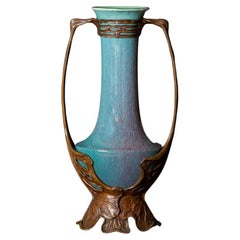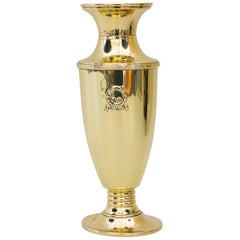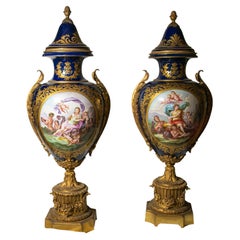Otto Eckmann
Exuding the boundless energy of the Munich art scene in the 1890s, Eckmann was the face of the Jugendstil movement. He created the Eckmann Type for the Karl Klingspor printers in Offenbach, a popular typeface of the day, and his illustrated work graced the cover of the art periodical, Jugend, 5 times. The swan, a favorite and recurring image which Eckmann employed in tapestries, textiles and prints, came to be the symbol of Jugendstil, itself. His career may have begun as a painter; however, by 1894 Eckmann swore off this artistic tie to fully embrace the Applied Arts by auctioning off every one of his paintings. In an accompanying letter to the auctioneer - no doubt typed using Eckmann typeface - his sentiments which he expressed for his paintings were “may we never meet again.” Eckmann’s output ran the gamut of the Applied Arts: from tapestries; color woodcuts for which he cut his blocks and made his inks; stained glass; jewelry; metal and silver objects; to furniture; designs for women’s fashion; book design and ceramics.
Early 1900s German Jugendstil Antique Otto Eckmann
Bronze
Early 1900s German Jugendstil Antique Otto Eckmann
Bronze
Early 1900s Austrian Jugendstil Antique Otto Eckmann
Brass
Early 20th Century French Louis Philippe Otto Eckmann
Bronze
Early 1900s Austrian Jugendstil Antique Otto Eckmann
Glass
Early 1900s Austrian Jugendstil Antique Otto Eckmann
Alpaca
Early 1900s Austrian Jugendstil Antique Otto Eckmann
Bronze
1910s Austrian Jugendstil Vintage Otto Eckmann
Bronze
Early 1900s Austrian Jugendstil Antique Otto Eckmann
Glass
Early 1900s Czech Jugendstil Antique Otto Eckmann
Glass
Early 1900s Austrian Jugendstil Antique Otto Eckmann
Bronze
Early 19th Century German Jugendstil Antique Otto Eckmann
Bronze
Late 19th Century German Jugendstil Antique Otto Eckmann
Faience
1910s Austrian Jugendstil Vintage Otto Eckmann
Brass



